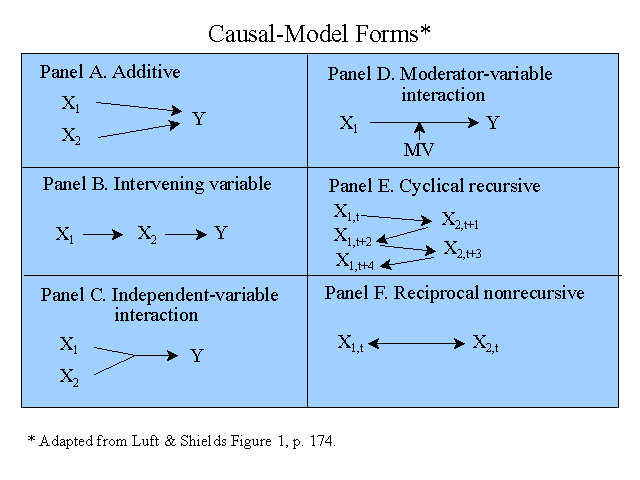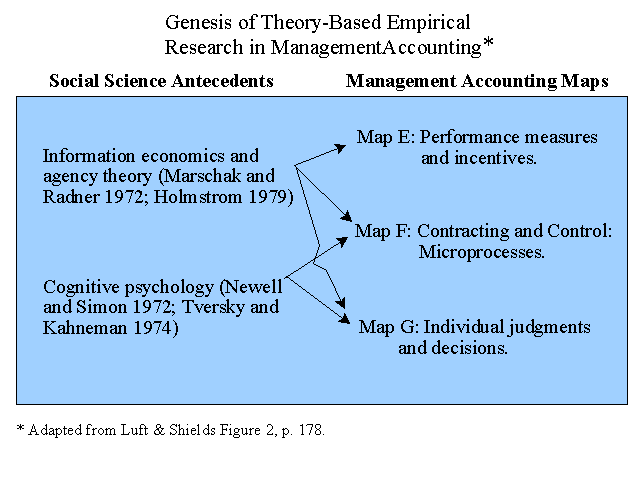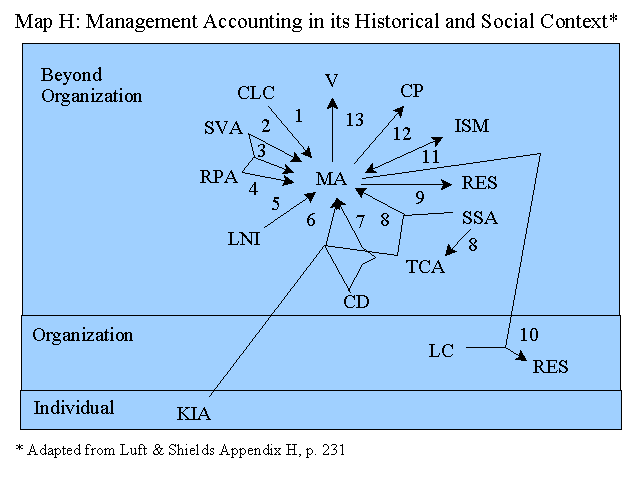
Summary by James R. Martin, Ph.D., CMA
Professor Emeritus, University of South Florida
Control/Controllership Main Page | History Main Page
| Research Methods Main Page
Separate streams of empirical research have developed in management accounting with different sets of questions, theories and research methods. Although numerous reviews of this literature have been published, many questions remain unanswered related to the completeness, validity and relationships between the various streams in this body of research. The purpose of this paper is to take a first step toward answering these questions using nine graphic presentations (maps) that summarize 275 empirical studies from six leading journals. The authors also provide seventeen guidelines for theory-consistent empirical accounting research.
The nine maps represent different streams of research and are intended to answer three main questions including:
1. What is researched?
2. What are the direction and shape of the explanatory links proposed?
3. What is the level of analysis? - individual, subunit, organization, or beyond organization.
Selection of Studies and Construction of Maps
The authors identify the six journals in this section and explain how the studies were chosen. The studies had to be empirical, explain causes and effects of variation in management accounting, and provide empirical evidence consistent with the theory used. The terms "variable" and "cause" are defined and the causal model forms are presented (see graphic below) and discussed. For example, in the additive model (Panel A), each independent variable Xi has an effect on the dependent variable Y that is not conditional on the value of any other independent variable, and it's own value is not conditional on Y or any other Xi.

The maps are constructed using 1 to 3 letter abbreviations for each variable. Variables that appear more than once on a map are italicized. Different arrow types indicate different relationships, e.g., positive vs. negative.
Overview of the Maps
The maps serve two purposes:
1. To provide a compact graphic summary of specific streams of research to enable a rapid tracing of what has been researched, what theory-consistent empirical evidence has been reported about a variable, and what unanswered questions might be suggested.
2. To identify additional basic issues related to how the different maps relate to each other.
The social science antecedents for each map are presented in Figure 2 for all nine maps. I separated Figure 2 into three parts to supplement my brief summary related to each map.

Map A relates to 42 studies (or study categories, e.g., 24 refers to 9 papers) that analyze individuals' encounters with budgeting. These studies build on the works shown on the left side of the illustration above. The non-accounting variables on the map include individual characteristics and attitudes, motivation, and performance. This map includes 47 variables represented by 1 to 3 letter abbreviations as indicated above. The studies are identified with the numbers from 1-42.
Map B involves 27 studies of budgeting at the organization and subunit levels and relates various budgeting variables to different non-accounting variables than those found on Map A, e.g., technology and organization structure. This map builds on contingency theory and includes a large number of variables.
Map C includes 35 studies related to information for planning and control and also uses contingency theory as a basis. Various perspectives include sociology, strategy, psychology and economics. A large number of variables are included ranging from advanced manufacturing practices to teamwork and use of management accounting information.
Map D is developed from 25 studies and only 31 variables related to implementing management accounting change. Variables include contingency variables such as environmental uncertainty, decentralization and vertical differentiation. Some management accounting variables include ABC, overhead allocations, quality measures and transfer pricing.

Map E includes connections for 34 studies and 66 variables related to performance measures and incentives. The key social science antecedent is the economic theory of agency. Non-accounting variables include prospector strategy and length of the product life cycle.
Map F is based on 36 studies in the area of contracting and control: micro processes. These studies are based on previous work in agency theory and cognitive psychology. Most of these studies examine individual or group actions in contracting such as specific offers and counteroffers. Variables range from bonus volatility to weight on higher level compensation.
Map G includes 49 studies on individual judgments and decisions connected to a large number of variables. Cognitive psychology provides the basis for the theory in this group of papers.

Map H is a much less involved illustration of research on management accounting in its historical and social context including 42 studies (grouped into 13 categories) and 14 variables. The social science antecedents are political economy, institutional sociology, political models of organizations and Foucault's discourse theory. Some variables include control of labor by capital, concealment of political issues and visibility of what is accounted for. (See an adaptation of this map below).
Map I on organizational change processes and the relation of financial and operational realities is also less involved than most of the previous maps and includes 18 categories of studies and 16 variables. The social science bases for this work include political models of organizations, discourse theory, ethnography and science studies. A key variable is management accounting change.
Sample Map
Most of the maps are rather involved and reproducing them would go well beyond my purpose in writing this short summary. However, my adaptation of the relatively simple Map below helps convey the idea of the mapping process.

The numbers from 1-13 represent the various research studies on this topic where each number, in this case, refers to a category of articles. The symbols on the map represent the various variables as follows: MA- Management accounting and control system development and use. CD - Calculative discourse. CLC - Control of labor by capital. CP - Concealment of political issues, e.g. power. ISM - Individual subjectivity is responsive to management accounting. KIA - Key individuals' actions supporting management accounting. LC - Local circumstances affecting resistance to management accounting. LNI - Limitations of non-accounting information such as memory failure. RES - Resistance to management accounting control systems and their effects. RPA - Resource pressure and resource allocation problems. SSA - State support for accounting, e.g., wartime economic controls and legal privileges for accountants. SVA - Symbolic value of managerial accounting. TCA - Technical capability (Management accounting) is available. V - Visibility of what is accounted for.
Causal-Model Forms and Levels of Analysis
The authors provide a table showing descriptive statistics on causal-model forms and levels of analysis and discuss their limitations related to what can be learned from the studies. For example, The problems identified include the following:
1. Out of 589 link-study pairs, only 6 were curvilinear rather than linear. Linear models fail to reveal how a variable's effect may change at different levels of the variable, e.g., more difficult levels of a budget.
2. The causal direction on the maps is almost always one way or unidirectional (95%).
3. 89% of the link-study pairs are single-level.
4. 37% of the link-study pairs show management accounting as given, while others (41%) show only causes but not effects of management accounting, i.e., show management accounting as a dependent variable.
Guidelines for Theory-Consistent Empirical Management Accounting Research
The last four sections of the paper (excluding the conclusion and appendix material, i.e., the 9 maps) provides a discussion of the following 17 guidelines for theory-consistent empirical management accounting research.
1. If a practice-defined variable is used, then clearly define its underlying theoretical properties including all properties whether they are related to the current study or not.
2. If a practice-defined variable can represent multiple theoretical properties, then gather evidence identifying their separate causes and effects.
3. If the theoretical property of interest belongs to only a definable subset of instances of the practice-defined variable (i.e., some ABC systems), then explicitly state this limitation.
4. A variable definition should not include content irrelevant to the research question and theory used, or exclude relevant content.
5. If theory predicts nonlinearities in the relation studied, then consider the value of capturing the nonlinearities.
6. If a linear model is used for the sake of simplicity, then state the resulting limitations explicitly.
7. If the causal model proposed is additive, then explain the reasons for assuming that there are no important intervening-variable or interaction relations as well as the consequences of omitting these relationships if they exist.
8. If the causal model proposed is conditional, then state the type of conditionality, i.e., intervening versus interacting.
9. For interaction models, specify whether the interaction is ordinal or disordinal.
10. For interaction models, state whether the interaction involves only independent variables or independent variables as well as moderator variables.
11. If unidirectional causality is assumed, then specify why bi-directionality is excluded.
12. Align the time frame of the study, i.e., length & frequency of evidence collection, and the time required for the cause examined to have an effect, i.e., the causal interval.
13. Specify whether the variable of interest varies across individuals, organizations, subunits, or beyond to entities such as markets and societies.
14. Align the level of theory, level of variable measurement, and level of data analysis, i.e., what is examined, source of evidence and unit of data.
15. If theoretical variables at multiple levels affect the observable measurements, then separate the effects from the multiple levels.
16. If cross-level effects are proposed, then use an interaction causal-model form, with at least one interacting variable at the level of the dependent variable.
17. If the variation of interest in a variable is variation in its value relative to a subset of other values in the sample, then use an individual-within-group-level model.
_____________________________________________
Related summaries:
Atkinson, A. A., R. Balakrishnan, P. Booth, J. M. Cole, T. Groot, T. Malmi, H. Roberts, E. Uliana and A. Wu. 1997. New directions in management accounting research. Journal of Management Accounting Research (9): 79-108. (Summary).
Buckley, J. W., M. H. Buckley and H. Chiang. 1976. Research Methodology & Business Decisions. National Association of Accountants. (Summary).
Covaleski, M. A., M. W. Dirsmith and S. Samuel. 1996. Managerial accounting research: The contributions of organizational and sociological theories. Journal
of Management Accounting Research (8): 1-35. (Summary).
Foster, G. and S. M. Young. 1997. Frontiers of management accounting research. Journal of Management Accounting Research (9): 63-77. (Summary).
Ittner, C. D. and D. F. Larcker. 2001. Assessing empirical research in managerial accounting: A value-based management perspective. Journal of Accounting and Economics (32): 349-410. (Summary).
Jonsson, S. 1998. Relate management accounting research to managerial work! Accounting, Organizations and Society 23(4): 411-434. (Summary).
Jonsson, S. and N. B. Macintosh. 1997. CATS, RATS, and EARS: Making the case for ethnographic accounting research. Accounting, Organizations and Society 22(3-4): 367-386. (Summary).
Kaplan, R. S. 1993. Research opportunities in management accounting. Journal of Management Accounting Research (5): 1-14. (Summary).
Kaplan, R. S. 1998. Innovation action research: Creating new management theory and practice. Journal of Management Accounting Research (10): 89-118. (Summary).
Kasanen, E., K. Lukka and A. Siitonen. 1993. The constructive approach in management accounting. Journal of Management Accounting Research (5): 243-264. (Summary).
Luft, J. L. 1997. Long-term change in management accounting: Perspectives from historical research. Journal of Management Accounting Research (9): 163-197. (Summary).
Lukka, K. and J. Mouritsen. 2002. Homogeneity or heterogeneity of research in management accounting? The European Accounting Review 11(4): 805-811. (Summary).
Otley, D. and A. Fakiolas. 2000. Reliance on accounting performance measures: Dead end or new beginning. Accounting, Organizations and Society 25(4-5): 497-510. (Summary).
Shields, M. D. 1997. Research in management accounting by North Americans in the 1990s. Journal of Management Accounting Research (9): 3-61. (Summary).